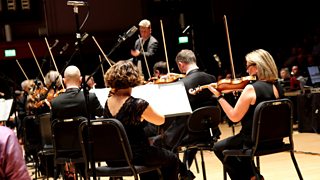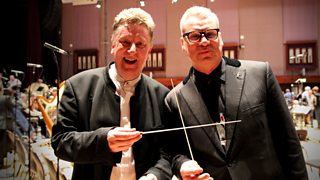Friday Night is Music Night Remixed
What is Friday Night is Music Night Remixed?
The BBC Concert Orchestra performed a very special Friday Night is Music Night that exclusively featured the music of that outstanding film composer John Williams. You can hear the concert again for 30 days on iPlayer Radio. However, we also have a very special treat for you that’s been put together with colleagues in BBC Research and Development which we're calling Friday Night is Music Night Remixed.

Friday Night is Music Night Remixed is a web page that lets you listen closely to different sections of the orchestra.
It's a really simple concept - the page starts with a zoomed-out video of the BBC Concert Orchestra, and you are then able to use the zoom bar on the right hand side to look more closely at each section of the orchestra.
And then – this is the exciting part – once you're zoomed in, the instruments you're looking at will become louder in the mix.
-
![]()
Try it Now
Try it here and have a play around. How does the opening of Jaws sound if you magnify the strings? What role does the brass section play in giving Star Wars its distinctive theme?
There are three tracks to remix:
Please note: Because it uses the latest web browser technology, Friday Night is Music Night Remixed only works on laptops and desktop computers running the Chrome browser on Windows or macOS. It works on Android phones/tablets but not iPhones or iPads.
How did we make it?
So you might be wondering how the Friday Night is Music Night Remixed web page works. We'll leave the detailed explanation for the R&D Blog as this is all powered by a project of theirs called Venue Explorer, but the overall idea is as follows.
We started by going along to the Watford Colosseum for the recording of the Friday Night is Music Night concert. During the concert we captured multi-track audio recordings of Star Wars, Jurassic Park and Jaws, which we then used to create four separate mixes of each piece – one with just the strings, one with just the brass, and likewise for the woodwind and percussion/piano.
With these four mixes (as well as the main radio mix that got transmitted on air) we had all the audio we needed. Now all that was left was to create a web page that would let you zoom in on the video. We set it up so that when a user looks at the video fully zoomed out, they hear the radio mix of the whole orchestra, and then as they zoom in we gradually lower the radio mix and raise the relevant individual mix (either strings, brass, woodwind, percussion/piano) depending on where the user is looking.
Find out more about our three pieces of music: Jaws
John Williams uses just two low notes from the celli and basses in an endless repetitive, unstoppable phrase. The result is a theme which is synonymous with tension, fear and a 25 foot, 3 ton great white shark!

This is a scary, cold underwater world. Listen out for woodwind and brass that create the swirling current of the ocean. You’ll hear a sea shanty theme – which John Williams returns to for the film’s closing credits. There’s a big crescendo as the menace approaches and then a moment of calm as the shark moves away. But then just when you thought it was safe to go back into the water… the full orchestra combine for the final attack.
Jurassic Park
Jurassic Park is a film score that has to capture fear, wonder, adventure and dinosaurs. In the introduction to the published score John Williams pondered “what the trumpeting of these great beasts of the distant past must have been like”. In the film he gives their voice to a French horn echoing across the valleys of the Isla Nublar. The Dinosaurs’ theme is one of grace and beauty. The first time we hear it in the film – it’s upstaged somewhat on screen by a Brachiosaurus - albeit an animatronic one. But despite a stellar Hollywood cast this musical theme leaves us in no doubt about the real stars of the movie.
The piece then moves on to a second theme “Journey to the Island” led by the trumpet section and written to accompany shots of the stunning Jurassic Park scenery of mountains, forests and waterfalls.
Star Wars
When John Williams started work on the score for Star Wars he knew little more than it was a spaceship movie. In later years he said – “I hope I wrote something mysterious, dramatic, and hugely effective”. In 2005 the American Film Institute named the soundtrack to Star Wars as the most memorable film score of all time.
Throughout his Star Wars scores John used ‘leitmotifs’ – a musical theme or phrase to identify a particular character. It’s a device used by classical composers particularly Wagner and Puccini. The big main theme is often identified with Luke Skywalker but listen out for the Rebel Fanfares and, of course, the beautiful Princess Leia theme. Poor Darth Vader has to wait for the score to “The Empire Strikes Back” before he gets his own sinister Imperial March!





